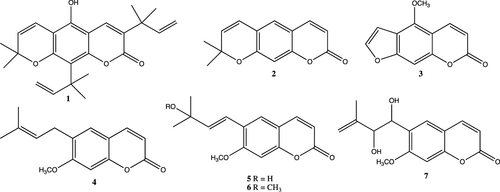当前位置:
X-MOL 学术
›
ACS Food Sci. Technol.
›
论文详情
Our official English website, www.x-mol.net, welcomes your
feedback! (Note: you will need to create a separate account there.)
Chemical Composition and Synergistic Antimicrobial Effects of a Vegetatively Propagated Cameroonian Lemon, Citrus x limon (L.) Osbeck
ACS Food Science & Technology ( IF 2.6 ) Pub Date : 2021-02-17 , DOI: 10.1021/acsfoodscitech.0c00071 Mohamed Foundikou Nsangou 1 , Emmanuel Ngeufa Happi 1 , Simone Véronique Fannang 2 , Albert Fouda Atangana 3 , Alain François Kamdem Waffo 1 , Jean Duplex Wansi 1 , Sani M. Isyaka 4 , Nicholas Sadgrove 5 , Nobert Sewald 6 , Moses K. Langat 5
ACS Food Science & Technology ( IF 2.6 ) Pub Date : 2021-02-17 , DOI: 10.1021/acsfoodscitech.0c00071 Mohamed Foundikou Nsangou 1 , Emmanuel Ngeufa Happi 1 , Simone Véronique Fannang 2 , Albert Fouda Atangana 3 , Alain François Kamdem Waffo 1 , Jean Duplex Wansi 1 , Sani M. Isyaka 4 , Nicholas Sadgrove 5 , Nobert Sewald 6 , Moses K. Langat 5
Affiliation

|
This study analyzed the antimicrobial effects of compounds present in the roots and leaves of Citrus x limon (L.) Osbeck to help understand how this plant (1) ecologically modulates microbial defense in the rhizosphere and (2) protects against food-borne bacterial pathogens. Antimicrobial effects of C. limon collected from a farm in Foumban in Cameroon are reported against Salmonella typhi, Salmonella typhimurium, Salmonella enteritidis, Escherichia coli, Shigella flexineri, and Saccharomyces cerevisiae. The study modeled synergistic antifungal effects of an essential oil from the roots of C. limon or E-caryophyllene when combined with the isolated compounds against S. cerevisiae. Twenty-four compounds were identified from the methanol extracts of the roots and leaves: 10 prenylated coumarins (1–10), six methoxylated flavones (11–16), two limonoids (18 and 19), a phenylalanine derivative (20), lupeol, stigmasterol, sitosterol, and sitosterol-3-O-β-d-glucoside. Major compound 16, atalantoflavone, was esterified using lauric acid to yield the undescribed 5,4′-dilaureate atalantoflavone (16a). The essential oil from the roots contained methyl esters of hexadecanoic acid (39%) and 9-octadecenoic acid (9.3%) and sesquiterpenes β-bisabolene (10.1%) and α-santalene (8.0%). The antimicrobial effects of the root extract, leaf extract, compounds 1, 2, 4, 7–9, 11, 12, 14, 16, 16a, and 18 were evaluated against S. typhi, S. typhimurium, S. enteritidis, E. coli, S. flexineri, and S. cerevisiae. Compounds 11, 16, and 18 from the root extract of C. x limon showed significant antimicrobial effects with a minimum inhibitory concentration (MIC) of 62.5 μg/mL against S. flexineri, whereas compounds 5, 7, 11, and 18 showed significant antimicrobial effects with a MIC of 62.5 μg/mL against S. typhi. The essential oil from the roots synergized compounds 11–14 against S. cerevisiae. A synergistic MIC of 7.8 μg/mL was registered by combining 12 and E-caryophyllene.
中文翻译:

营养繁殖的喀麦隆柠檬,柑橘x柠檬(L.)Osbeck的化学成分和协同抗菌作用
这项研究分析了柑橘x柠檬(Osbeck)的根和叶中存在的化合物的抗菌作用,以帮助了解这种植物(1)如何生态调节根际的微生物防御,以及(2)预防食源性细菌病原体。据报道,从喀麦隆丰姆的一个农场收集的柠檬柠檬杆菌对伤寒沙门氏菌,鼠伤寒沙门氏菌,肠炎沙门氏菌,大肠杆菌,志贺氏菌和酿酒酵母具有抗微生物作用。该研究建立了柠檬柠檬根或柠檬根的香精油的协同抗真菌作用模型。当与分离的化合物抗酿酒酵母结合时,E-石竹烯。从根和叶的甲醇提取物中鉴定出二十四种化合物:10种烯丙基香豆素(1-10),6种甲氧基黄酮(11-16),2种柠檬苦素(18和19),苯丙氨酸衍生物(20),羽扇豆酚,豆甾醇,谷甾醇和谷甾醇-3 - O - β - d-葡萄糖苷。使用月桂酸酯化主要化合物16阿塔兰黄酮,得到未描述的5,4'-二氢呋喃二甲酸阿塔兰黄酮(16a)。根中的精油含有十六烷酸(39%)和9-十八碳烯酸(9.3%)的甲酯,倍半萜类β-bisabolene(10.1%)和α-檀香烯(8.0%)。根提取物,叶提取物,化合物的抗微生物作用1,2,4,7-9,11,12,14,16,16A,和18分别针对评估伤寒沙门氏菌,鼠伤寒沙门氏菌,肠炎沙门氏菌,E大肠杆菌,屈氏链球菌和酿酒酵母。化合物11,16和18从根提取物C. X柠檬表现出与打击62.5微克/毫升的最小抑制浓度(MIC)显著抗菌效果S. flexineri,而化合物5,7,11,和18显示出与一个显著抗菌效果对伤寒沙门氏菌的MIC为62.5μg/ mL 。从根中提取的精油可协同化合物11-14对抗酿酒酵母。通过将12和E-石竹烯结合使用,协同MIC为7.8μg / mL 。
更新日期:2021-04-23
中文翻译:

营养繁殖的喀麦隆柠檬,柑橘x柠檬(L.)Osbeck的化学成分和协同抗菌作用
这项研究分析了柑橘x柠檬(Osbeck)的根和叶中存在的化合物的抗菌作用,以帮助了解这种植物(1)如何生态调节根际的微生物防御,以及(2)预防食源性细菌病原体。据报道,从喀麦隆丰姆的一个农场收集的柠檬柠檬杆菌对伤寒沙门氏菌,鼠伤寒沙门氏菌,肠炎沙门氏菌,大肠杆菌,志贺氏菌和酿酒酵母具有抗微生物作用。该研究建立了柠檬柠檬根或柠檬根的香精油的协同抗真菌作用模型。当与分离的化合物抗酿酒酵母结合时,E-石竹烯。从根和叶的甲醇提取物中鉴定出二十四种化合物:10种烯丙基香豆素(1-10),6种甲氧基黄酮(11-16),2种柠檬苦素(18和19),苯丙氨酸衍生物(20),羽扇豆酚,豆甾醇,谷甾醇和谷甾醇-3 - O - β - d-葡萄糖苷。使用月桂酸酯化主要化合物16阿塔兰黄酮,得到未描述的5,4'-二氢呋喃二甲酸阿塔兰黄酮(16a)。根中的精油含有十六烷酸(39%)和9-十八碳烯酸(9.3%)的甲酯,倍半萜类β-bisabolene(10.1%)和α-檀香烯(8.0%)。根提取物,叶提取物,化合物的抗微生物作用1,2,4,7-9,11,12,14,16,16A,和18分别针对评估伤寒沙门氏菌,鼠伤寒沙门氏菌,肠炎沙门氏菌,E大肠杆菌,屈氏链球菌和酿酒酵母。化合物11,16和18从根提取物C. X柠檬表现出与打击62.5微克/毫升的最小抑制浓度(MIC)显著抗菌效果S. flexineri,而化合物5,7,11,和18显示出与一个显著抗菌效果对伤寒沙门氏菌的MIC为62.5μg/ mL 。从根中提取的精油可协同化合物11-14对抗酿酒酵母。通过将12和E-石竹烯结合使用,协同MIC为7.8μg / mL 。











































 京公网安备 11010802027423号
京公网安备 11010802027423号